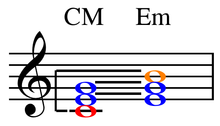- Contrast chord
-
In music, a contrast chord is an auxiliary chord formed from one of the three primary triads and sharing its diatonic function. Leittonwechselklänge (German: "leading-tone contrast chords"), abbreviated Tl in major and tL in minor.
If chords may be formed by raising (major) or lowering (minor) the fifth a whole step [ parallel chords], they may also be formed by lowering (major) or raising (minor) the root a half-step to wechsel, the leading tone or leitton. These chords are Leittonwechselklänge (literally: "leading-tone changing sounds"), sometimes called gegenklang or "contrast chord". [1]
Leittonwechselklänge Mode Key Position Major E minor Tl A minor Sl B minor Dl Minor Ab major tL Db major sL Eb major dL - Major Leittonwechselklänge, formed by lowering the root a half step.
- Minor Leittonwechselklänge, formed by raising the root (US)/fifth (German) a half step.
Sources
- ^ Gjerdingen, Robert O. (1990). "A Guide to the Terminology of German Harmony", Studies in the Origin of Harmonic Tonality by Dahlhaus, Carl, trans. Gjerdingen (1990). Princeton University Press. ISBN 0-691-09135-8.
External links
- “A Guide to the Terminology of German Harmony”, in Studies on the Origin of Harmonic Tonality, pp. xi–xv (Princeton: Princeton Univ. Press, 1990). "Published Papers", Robert Gjerdingen.
Chords By type Major · Minor · Dominant · Dominant seventh flat five · Diminished · Half-diminished · Diminished major · Minor-major · Augmented major · Augmented minor · Nondominant · Harmonic seventh chordAdded
/ omittedBy function SecondaryWith names Elektra chord · Farben chord · Hendrix chord · Mu chord · Mystic chord · Northern lights chord · Petrushka chord · Power chord · Psalms chord · So What chord · Spider chord · Tristan chord · Viennese trichord · Dream chordOther Common chord (music) · Mixed interval · Open chord · Polychord · Primary triad · Quartal and quintal · Slash chord · Subsidiary chord · Synthetic chord · Tone clusterCategories:- Chords
Wikimedia Foundation. 2010.



